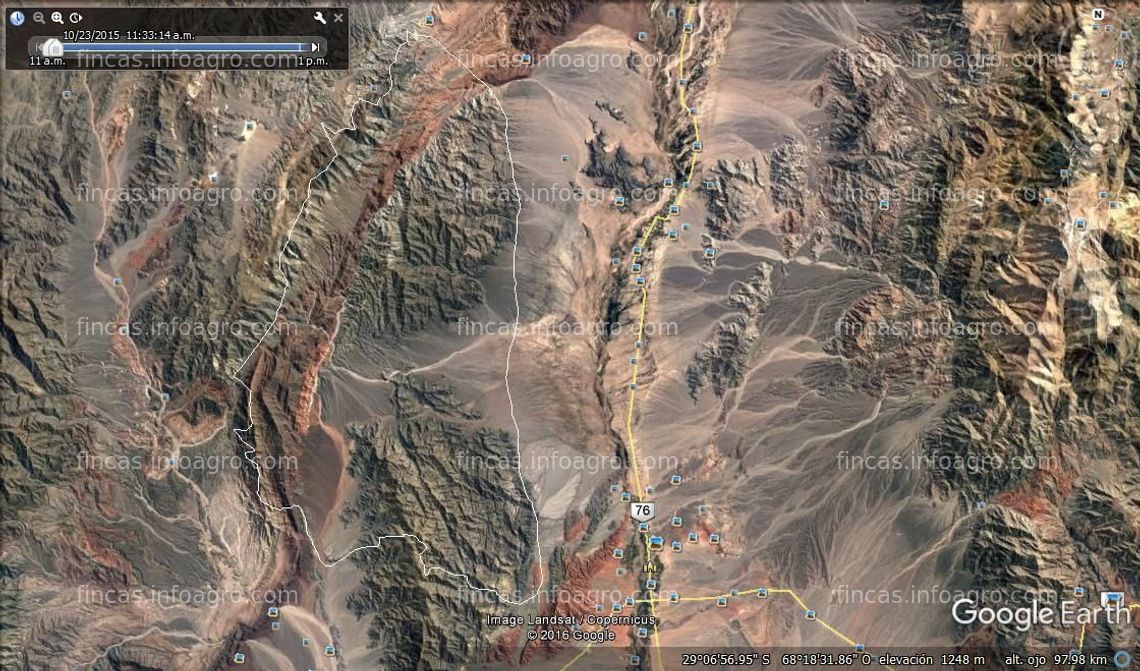En venta Farm of 80.000 hectares at La Rioja, Argentina
150 $
800,000,000 m²
(80,000 ha.)
Farm for sale at La Rioja province, Argentina
The Sierra de Maz is part of what is called the
Western Pampeanas Sierras. This is a mountainous system located throughout the
region of the Argentine Northwest, from Cordoba and San Luis to the Northwest
of Tucumán and Catamarca. They have a marked north-south direction. To the
west, there are heights above 5000 m where eternal snows can be seen. Some
slopes of the East are covered by very dense vegetation. Towards the interior
they contain some plains and interior plateaus, "pampas, with heights that
although they reach almost always the 1,000 or 1,500 m can reach, as in the Farm
of the Arenal to 2,300 m of height. At the edges of the system, towards the
south of the former, there are some sierras such as those of Ancasti, Ambato,
Mazán and Velasco, which can reach heights of 3,500 m or 4,000 m. Further
south, the Sierras de Los Llanos (1,700 m) appear to be immersed in the farm of
powerful sediment masses coming from the same mountains. There are some
mountain ranges of the south part of La Rioja, some frankly in San Juan; The
Sierras of the Fertile Valley, the Huerta, the Giant, Guayabes and Los
Colorados appear, with an evident direction of the NW-SE ridges.
Some characteristics of structure and morphology are common to most of the Sierras Pampeanas. They have rugged, raised and tilted blocks of crystalline rocks of Precambrian and Paleozoic age, originating from the Brazilian shield and included in Andean orogeny. They offer a solid appearance and their limbs gradually sink into the materials that have been ripped from them and filled the neighboring depressed regions. The main morphological characteristics of the mountain ranges seem to come from their structure (Figueroa, 1976). Some faults have given rise to high slopes that delimit the blocks, in which the upper levels correspond to old surfaces of flattening. A dense network of fault fractures orients the valleys and ravines that disclose the slopes of the mountains. In addition, we can see the existence of tectonic trenches located in the interior of the mountain ranges or on its edges, where individual flat surfaces, sometimes located in the heights (Pampas) as well as a considerable number in the bottom of basins and valleys, acquiring in the plains considerable extension, separating the saws between them. Many of these surfaces do not have drainage outwards; In some cases, barren and saline.
The contact between the saws and the flat region is of particular interest; Is defined by a series of glacis or dejection cones that form a relief sloping from the exit of the ravines, and, on which the waters drain, loaded with alluviums from the basins and slopes. The interior plains or basins (plains, farms, etc.) located between the saws are largely covered with a discontinuous mantle of quaternary formations of alluvial or wind origin. In some sectors, particularly in the edge of the mountains and erosion, but also in the plains arise stoneware and stratified clays of variable age, going from the Paleozoic to the Upper Tertiary. In general these ancient sediments have been deposited near the crystalline blocks of the mountain ranges and it is possible to observe them with their elements superposed to the base rocks, as it happens in the mountain ranges of Paganzo and in Los Colorados. Here, as elsewhere, water erosion accentuated by strong local winds may have formed distinctive ruin-like reliefs, as in Los Mogotes Colorados.
The predominant North-South direction of the basins, with slight regional variations, directs the atmospheric circulation and allows to explain certain contrasts of climate and vegetation according to the exposure of the slopes.
LOCATION
The "Sierras de Maz", located 35 kilometers east of Villa Unión City, La Rioja, Argentina, is reached by a paved route to the gate of the farm.
Villa Unión is the capital city of the department of Coronel Felipe Varela, located to the west of the province of La Rioja, Argentina, in the valley of the river Bermejo. This city is located at a height of 1240 meters above sea level and on the right bank of the river Vinchina or Bermejo and is characterized by agricultural activity and tourism.
Here the administrative and technical dependencies of the Talampaya National Park operate, this makes of the city a great tourist destination with proposals of all levels: 4 *, 3 *, 2 *, lodging, cabaña, dto., Houses, camping; Service stations; Banks and ATMs; restaurants; Internet; telephony; Supermarkets; transportation; Tourism companies with transport of combis, micro, 4x4 pickup, mountain bikes, horseback riding and guides, with English, French and Portuguese.
It is located in the valley formed by the Sierra de Famatina (to the east) and the La Rioja precordillera (to the west), in a bag of arid climate, with very hot summers and benign winters, very few rains and probability of frost; 275 km west of the provincial capital, by the RN 76.
The region of Coronel Felipe Varela grows economically, in the Bermejo Valley, with production of organic agriculture.
Some Distances:
27 km from Villa Unión.
278 km from LA RIOJA CAPITAL.
571 Km from Córdoba Capital.
At 1261 Km from Buenos Aires.
To 296 km of the International Pass Agua Negra in San Juan (Argentina-Chile).
Nearest airports:
National and International Flights in Rep. Argentina: La Rioja Airport 278 km; In Cordoba to 571 km; In Buenos Aires to 1265 Km.dCategorías a las que pertenece:
- Agrícolas rústicas
- Explotaciones ganaderas
LA Rioja, Argentina
¿Ves algún error?
Infórmanos de cualquier error para poder corregirlo.
Contactar con el anunciante
Propietario

Alejandro Walker




